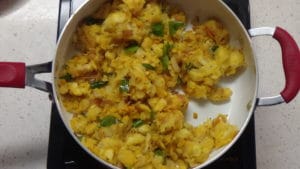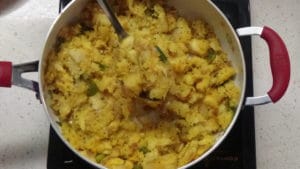Tapioca podimas is a stir fry recipe made with tapioca root also known in the names of maravalli kizhangu, kappa kizhangu and kuchi kizhangu.
Maravalli kizhangu Alias Tapioca is a root vegetable widely consumed and liked by many all over the world. Kappa kizhangu is very famous in southern parts of India and used in many recipes like cutlets, gravies, curries and stir-fries.
In fact, Maravalli kizhangu is a tasty vegetable and can be consumed boiled just by cooking with a little salt. This tapioca podimas is a simple stir fry recipe with boiled kappa, onions, and chillies.
Tapioca podimas | Maravalli kizhangu recipe | Kerala kappa stir fry
Make sure not to overcook the kuchi kizhangu as it will become mushy while making the podimas. I like a slightly oil-roasted texture in the podimas hence I pressure cook the roots just for two whistles.
Cooking in an open pan definitely takes a long time and not required as every single house owns a cooker(electric or pressure) these days.
It is essential to peel cassava and never eat it raw. It contains dangerous levels of cyanide unless a person cooks it thoroughly before eating it.
Due to its cyanide content, people must cook cassava very carefully.
- peeling the cassava root and slicing it
- boiling, baking, roasting, or frying it until it is tender and very well-cooked
- discarding any cooking water

Tapioca has lots of essential nutrients and some of them are:
Cassava or Tapioca is a calorie-rich vegetable that contains plenty of carbohydrates and key vitamins and minerals.
Tapioca is a good source of vitamin C, thiamine, riboflavin, and niacin.
Moreover, Tapioca root is a source of resistant starch, which scientists suggest can boost a person’s gut health by helping nurture beneficial gut bacteria.
It is possible to use tapioca starch to make gluten-free baked goods. As long as people take precautions when preparing it, cassava can be a beneficial addition to the diet.
Health information source: https://www.medicalnewstoday.com/
You may like to try these random recipes:
Do you know I have a YouTube channel also and the videos are uploaded regularly? I have embedded the video here for your reference.
Please check the video uploaded in the recipe card and subscribe if you like my style of video making.

Tapioca podimas | Maravalli kizhangu recipe | Kerala kappa stir fry
Ingredients
Ingredients:
- 2 tapioca roots (Maravalli kizhangu)
- 4 tbsp oil (preferably coconut oil)
- 1 tsp mustard seeds
- 1 tsp cumin seeds
- 2 tbsp gram dal
- 1 cup chopped onions
- 4 green chillies
- Few curry leaves
- 1 tsp salt (as per taste)
- ½ tsp turmeric powder
Instructions
Preparation:
How to cook Tapioca ( boiling kappa kizhangu)
- Wash Tapioca root thoroughly with lots of water to remove the soil and dirt.
- Break the kizhangu into two pieces and make lengthy slits in multiple places like this.
- For more clarification please check the video.
- Remove the outer brown peel with the thicker inner layer like this.
- The final clean roots should look like this.
- Take them in a pressure cooker and add water to cover them fully.
- Cover with the lid and pressure cook for two full whistles on high.
- Let the pressure settle on its own, drain all the water and take the boiled tapioca.
Recipe:
How to make maravalli kizhangu podimas:
- Mash the boiled tapioca with a potato masher.
- Heat oil in a pan ( preferably a nonstick pan).
- Add mustard seeds and cumin seeds.
- Let the mustard crackle and add gram dal.
- Fry the dal until golden color and chopped onions.
- Saute onions until they turn transparent.
- Add slit green chillies with some curry leaves.
- Put some turmeric powder, and required salt.
- Now add the mashed tapioca and mix well.
- It requires a proper mixing so that the kizhangu combines well with the onions and peppers.
- Now keep the heat to lower setting, cover with a lid and let the kappa kizhangu absorb the spices.
- After 5 mins, mix once again and switch off.
- Serve as a side dish for rice or chapati. We love to have this kuchi kizhangu podimas just as it is for a healthy breakfast or early dinner.
Video
Notes
1) Always use the maravalli kizhangu within a week while they are still fresh.
2) Do not overcook the tapioca as it may become too mushy and difficult to get the right texture.
3) If you want to have the boiled kizhangu as it is add some rock salt in the water while cooking.
Nutrition
Preparation:
How to cook Tapioca ( boiling kappa kizhangu):
- Wash Tapioca root thoroughly with lots of water to remove the soil and dirt.
- Break the kizhangu into two pieces and make lengthy slits in multiple places like this.

- For more clarification please check the video. Remove the outer brown peel with the thicker inner layer like this.

- The final clean roots should look like this.

- Take them into a pressure cooker and add water to cover them fully.

- Cover with the lid and pressure cook for one or two full whistles on high. Do not over cook.

- Let the pressure settle on its own, drain all the water and take the boiled tapioca.
Recipe:
How to make maravalli kizhangu podimas:
- Mash the boiled tapioca with a potato masher.

- Heat oil in a pan ( preferably a nonstick pan). Add mustard seeds and cumin seeds. Let the mustard crackle and add gram dal.

- Fry the dal until golden color and chopped onions.

- Saute onions until they turn transparent.
- Add slit green chillies with some curry leaves.

- Put some turmeric powder, and required salt.


- Now add the mashed tapioca and mix well.

- It requires proper mixing so that the kizhangu combines well with the onions and peppers.

- Now keep the heat to a lower setting, cover with a lid and let the kappa kizhangu absorb the spices.

- After 5 mins, mix once again and switch off.

- Serve as a side dish for rice or chapati. We love to have this kuchi kizhangu podimas just as it is for a healthy breakfast or early dinner.
Tips:
1) Always use the maravalli kizhangu within a week while they are still fresh.
2) Do not overcook the tapioca as it may become too mushy and difficult to get the right texture.
3) If you want to have the boiled kizhangu just as it is add some rock salt in the water while cooking.



